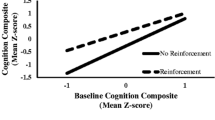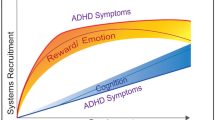Abstract
Motivational models emphasizing altered reinforcement sensitivity have been increasingly implicated in etiological accounts of attention-deficit/hyperactivity disorder (ADHD). Overactive behavioral approach tendencies are identified among these motivational models and are addressed within reinforcement sensitivity theory (RST). RST proposes that overactive behavioral approach is associated with over responsiveness to immediately reinforcing stimuli and results from an overactive appetitive motivational subsystem of the brain—the behavioral approach system. The current study tested the hypothesis that behavioral approach would be higher in a clinical sample of adults diagnosed with ADHD relative to a control group. Experimental and self-report measures of behavioral approach were administered. Behavioral approach was higher in the ADHD group across both methods of assessment. Effect size estimates fell within the medium to large range. Implications for how these findings might be incorporated into future ADHD models are discussed.
Similar content being viewed by others
References
Al-Adawi, S., & Powell, J. (1997). The influence of smoking on reward responsiveness and cognitive functions: a natural experiment. Addiction, 92, 1773–1782.
American Psychiatric Association. (2000). Diagnostic and statistical manual of mental disorders (4th ed.). Washington: Author.
Ávila, C., & Parcet, M. A. (2000). The role of Gray’s impulsivity in anxiety-mediated differences in resistance to extinction. European Journal of Personality, 14, 185–198.
Barkley, R. A. (1997). Behavioral inhibition, sustained attention, and executive functions: Constructing a unifying theory of ADHD. Psychological Bulletin, 121, 65–94.
Barkley, R. A., & Murphy, K. R. (2006). Attention-deficit/hyperactivity disorder: A clinical workbook (3rd ed.). New York: Guilford.
Barrós-Loscertales, A., Meseguer, V., Sanjuán, A., Belloch, V., Parcet, M. A., Torrubia, R., et al. (2006). Striatum gray matter reduction in males with an overactive behavioral activation system. European Journal of Neuroscience, 24, 2071–2074.
Beauchaine, T. (2001). Vagal tone, development, and Gray’s motivational theory: toward an integrated model of autonomic nervous system functioning in psychopathology. Development and Psychopathology, 13, 183–214.
Beaver, J. D., Lawrence, A. D., van Ditzhuijzen, J., Davis, M. H., Woods, A., & Calder, A. J. (2006). Individual differences in reward drive predict neural responses to images of food. Journal of Neuroscience, 26, 5160–5166.
Belendiuk, K. A., Clarke, T. L., Chronis, A. M., & Raggi, V. L. (2007). Assessing the concordance of measures used to diagnose adult ADHD. Journal of Attention Disorders, 10, 276–287.
Biederman, J., Faraone, S. V., Spencer, T. J., Mick, E., Monuteaux, M. C., & Aleardi, M. (2006). Functional impairments in adults with self-reports of diagnosed ADHD: a controlled study of 1001 adults in the community. Journal of Clinical Psychiatry, 67, 524–540.
Bijttebier, P., Beck, I., Claes, L., & Vandereycken, W. (2009). Gray’s reinforcement sensivity theory as a framework for research on personality-psychopathology associations. Clinical Psychology Review, 29, 421–430.
Cohen, J. (1988). Statistical power analysis for the behavioral sciences. New York: New York Academy Press.
Conners, C. K., Erhardt, D., & Sparrow, E. (1999). Conners adult ADHD rating scales. North Tonawanda: Multi-Health Systems.
Cooper, A. C., & Gomez, R. (2008). The development of a short form of the sensitivity to punishment and sensitivity to reward questionnaire. Journal of Individual Differences, 29, 90–104.
Corr, P. J. (Ed.). (2008). The reinforcement sensitivity theory of personality. Cambridge: Cambridge University.
Dawkins, L., Powell, J. H., Pickering, A., Powell, J., & West, R. (2009). Patterns of change in withdrawal symptoms, desire to smoke, reward motivation and response inhibition across 3 months of smoking abstinence. Addiction, 104, 850–858.
DuPaul, G. J., Power, T. J., Anastopoulos, A. D., & Reid, R. (1998). ADHD Rating Scale-IV: Checklists, norms, and clinical interpretation. New York: Guilford.
Erhardt, D., Epstein, J. N., Conners, C. K., Parker, J. D. A., & Sitarenios, G. (1999). Self ratings of ADHD symptoms in adults II: reliability, validity, and diagnostic sensitivity. Journal of Attention Disorders, 3, 153–158.
Farmer, R. F. (2005). Temperament, reward and punishment sensitivity, and clinical disorders: implications for behavioral case formulation and therapy. International Journal of Behavioral and Consultation Therapy, 1, 56–76.
Farmer, R. F., & Rucklidge, J. J. (2006). An evaluation of the response modulation hypothesis in relation to attention-deficit/hyperactivity disorder. Journal of Abnormal Child Psychology, 34, 545–557.
Goldsmith, H. H., Lemery, K. S., & Essex, M. J. (2004). Roles for temperament in the liability to psychopathology in childhood. In L. DiLalla (Ed.), Behavior genetic principles: Development, personality, and psychopathology (pp. 19–39). Washington: American Psychological Association.
Gomez, R. (2003). Underlying processes in the poor response inhibition of children with attention-deficit/hyperactivity disorder. Journal of Attention Disorders, 6, 111–122.
Gomez, R., & Corr, P. J. (2010). Attention-Deficit/Hyperactivity Disorder symptoms: Association with Gray’s and Tellegen’s models of personality. Personality and Individual Differences, 49, 902–906.
Gray, J. A., & McNaughton, N. (2000). The neuropsychology of anxiety: An enquiry into the functions of the septo-hippocampal system (2nd ed.). New York: Oxford University.
Hundt, N. E., Kimbrel, N. A., Mitchell, J. T., & Nelson-Gray, R. O. (2008). High BAS, but not low BIS, predicts externalizing symptoms in adults. Personality and Individual Differences, 44, 563–573.
Kambouropoulos, N., & Staiger, P. K. (2001). The influence of sensitivity to reward on reactivitiy to alcohol-related cues. Addiction, 96, 1175–1185.
Kane, T. A., Loxton, N. J., Staiger, P. K., & Dawe, S. (2004). Does the tendency to act impulsively underlie binge eating and alcohol use problems? An empirical investigation. Personality and Individual Differences, 36, 83–94.
Kimbrel, N. A. (2008). A model of the development and maintenance of generalized social phobia. Clinical Psychology Review, 28, 592–612.
Luman, M., Oosterlaan, J., & Sergeant, J. A. (2005). The impact of reinforcement contingencies on ADHD: a review and theoretical appraisal. Clinical Psychology Review, 25, 183–213.
Marco, R. M., Miranda, A., Schlotz, W., Melia, A., Mulligan, A., Müller, U., et al. (2009). Delay and reward choice in ADHD: an experimental test of the role of delay aversion. Neuropsychology, 23, 367–380.
Mitchell, J. T. (2010). Behavioral approach in ADHD: testing a motivational dysfunction hypothesis. Journal of Attention Disorders, 13, 609–617.
Mitchell, J. T., & Nelson-Gray, R. O. (2006). Attention-deficit/hyperactivity disorder symptoms in adults: relationship to Gray’s behavioral approach system. Personality and Individual Differences, 40, 749–760.
Murphy, K. M., & Barkley, R. A. (1996). Prevalence of DSM-IV symptoms of ADHD in adult licensed drivers: implications for clinical diagnosis. Journal of Attention Disorders, 1, 147–161.
Newman, J. P., & Wallace, J. F. (1993). Diverse pathways to deficient self-regulation: Implications for disinhibitory psychopathology in children. Clinical Psychology Review, 13, 699–720.
Nigg, J. T. (2001). Is ADHD a disinhibitory disorder? Psychological Bulletin, 127, 571–598.
Nigg, J. T. (2006). What causes ADHD? Understanding what goes wrong and why. New York: Guilford.
Nigg, J. T., Goldsmith, H. H., & Sachek, J. (2004). Temperament and attention deficit hyperactivity disorder: the development of a multiple pathway model. Journal of Clinical Child and Adolescent Psychology, 33, 42–53.
Nigg, J. T., Willcutt, E. G., Doyle, A. E., & Sonuga-Barke, E. J. S. (2005). Causal heterogeneity in attention-deficit/hyperactivity disorder: do we need neuropsychologically impaired subtypes? Biological Psychiatry, 57, 1224–1230.
National Institutes of Mental Health. (1997). Diagnostic interview schedule for children—IV (DISC-IV). New York: Columbia University.
Perkins, A. M., Cooper, A., Abdelall, M., Smillie, L. D., & Corr, P. J. (2010). Personality and defensive reactions: fear, trait anxiety, and threat magnification. Journal of Personality, 78, 1071–1090.
Perkins, A. M., & Corr, P. J. (2006). Reactions to threat and personality: psychometric differentiation of intensity and direction dimensions of human defensive behaviour. Behavioural Brain Research, 169, 21–28.
Perkins, A. M., Kemp, S. E., & Corr, P. J. (2007). Fear and anxiety as separable emotions: an investigation of the revised reinforcement sensitivity theory of personality. Emotion, 7, 252–261.
Pickering, A. D., & Gray, J. A. (1999). The neuroscience of personality. In L. A. Pervin & O. P. John (Eds.), Handbook of personality: Theory and research (2nd ed., pp. 277–299). New York: Guilford.
Powell, J. H., Al-Adawi, S., Morgan, J., & Greenwood, R. J. (1996). Motivational deficits after brain injury: effects of bromocriptine in 11 patients. Journal of Neurology, Neurosurgery, and Psychiatry, 60, 416–421.
Powell, J. H., Pickering, A. D., Dawkins, L., West, J. F., & Powell, J. F. (2004). Cognitive and psychological correlates of smoking, abstinence, and predictors of successful cessation. Addictive Behaviors, 29, 1407–1426.
Quay, H. C. (1988). The behavioral reward and inhibition systems in child behavior disorder. In L. M. Bloomingdale (Ed.), Attention deficit disorder (New research in attention, treatment, and psychopharmacology, Vol. 3, pp. 176–186). New York: Pergamon.
Reuter, M., Schmitz, A., Corr, P., & Hennig, J. (2006). Molecular genetics support Gray’s personality theory: the interaction of COMT and DRD2 polymorphisms predicts the behavioral approach system. International Journal of Neuropsychopharmacology, 9, 155–166.
Rothbart, M. K., Ahadi, S. A., & Evans, D. E. (2000). Temperament and personality: origins and outcomes. Journal of Personality and Social Psychology, 78, 122–135.
Sagvolden, T., Johansen, E. B., Aase, H., & Russell, V. A. (2005). A dynamic developmental theory of attention-deficit/hyperactivity disorder (ADHD) predominately hyperactive/impulsive and combined subtypes. Behavioral and Brain Sciences, 28, 397–468.
Sonuga-Barke, E. J. S. (2002). Psychological heterogeneity in AD/HD—a dual pathway model of behaviour and cognition. Behavioural Brain Research, 130, 29–36.
Sonuga-Barke, E. J. S. (2003). The dual pathway model of ADHD: an elaboration of neuro-developmental characteristics. Neuroscience and Biobehavioral Reviews, 27, 593–604.
Spitzer, R. L., Williams, J. B., Gibbon, M., & First, M. B. (1990). User’s guide for the structured clinical interview for DSM-III-R: SCID. Washington: American Psychiatric.
Stahl, S. M. (2006). Essential psychopharmacology: The prescriber’s guide. Cambridge: The Cambridge University Press.
Tannock, R., Schachar, R., & Logan, G. (1995). Methylphenidate and cognitive flexibility: dissociated dose effects in hyperactive children. Journal of Abnormal Child Psychology, 23, 235–266.
Torrubia, R., Ávila, C., Moltó, J., & Caseras, X. (2001). The sensitivity to punishment and sensitivity to reward questionnaire (SPSRQ) as a measure of Gray’s anxiety and impulsivity dimensions. Personality and Individual Differences, 31, 837–862.
Willcutt, E. G., Pennington, B. F., Chhabildas, N. A., Friedman, M. C., & Alexander, J. (1999). Psychiatric comorbidity associated with DSM-IV ADHD in a nonreferred sample of twins. Journal of the American Academy of Child and Adolescent Psychiatry, 38, 1355–1362.
Acknowledgment
Thank you Arthur Anastopoulos, Ph.D. and Laura Knouse, Ph.D. for assistance in participant recruitment and data collection.
Author information
Authors and Affiliations
Corresponding author
Rights and permissions
About this article
Cite this article
Mitchell, J.T., Robertson, C.D., Kimbrel, N.A. et al. An Evaluation of Behavioral Approach in Adults with ADHD. J Psychopathol Behav Assess 33, 430–437 (2011). https://doi.org/10.1007/s10862-011-9253-6
Published:
Issue Date:
DOI: https://doi.org/10.1007/s10862-011-9253-6




